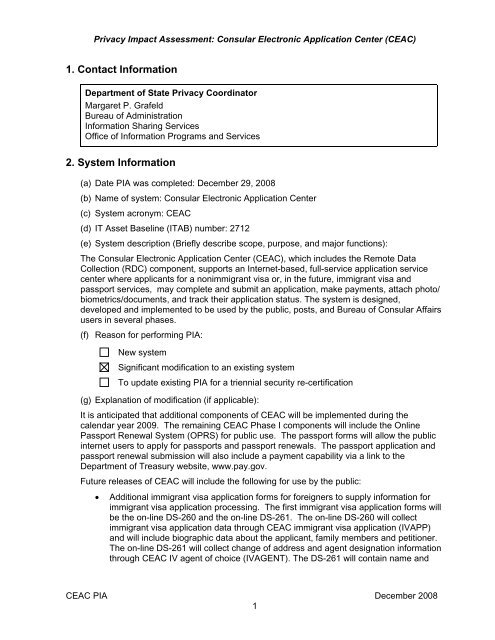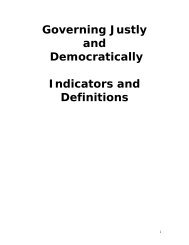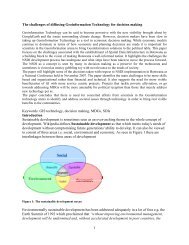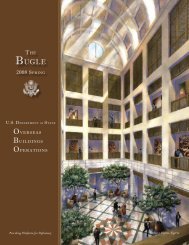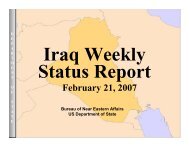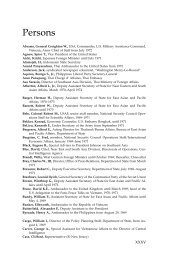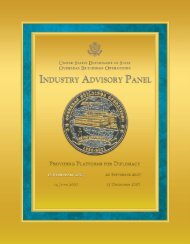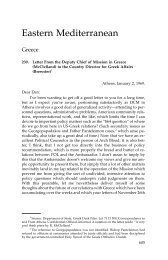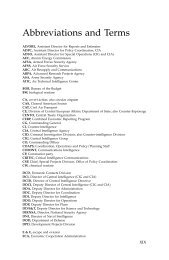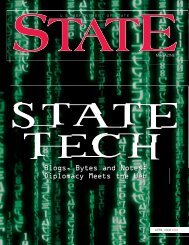Consular Electronic Application Center (CEAC) - US Department of ...
Consular Electronic Application Center (CEAC) - US Department of ...
Consular Electronic Application Center (CEAC) - US Department of ...
Create successful ePaper yourself
Turn your PDF publications into a flip-book with our unique Google optimized e-Paper software.
Privacy Impact Assessment: <strong>Consular</strong> <strong>Electronic</strong> <strong>Application</strong> <strong>Center</strong> (<strong>CEAC</strong>)<br />
1. Contact Information<br />
<strong>Department</strong> <strong>of</strong> State Privacy Coordinator<br />
Margaret P. Grafeld<br />
Bureau <strong>of</strong> Administration<br />
Information Sharing Services<br />
Office <strong>of</strong> Information Programs and Services<br />
2. System Information<br />
(a) Date PIA was completed: December 29, 2008<br />
(b) Name <strong>of</strong> system: <strong>Consular</strong> <strong>Electronic</strong> <strong>Application</strong> <strong>Center</strong><br />
(c) System acronym: <strong>CEAC</strong><br />
(d) IT Asset Baseline (ITAB) number: 2712<br />
(e) System description (Briefly describe scope, purpose, and major functions):<br />
The <strong>Consular</strong> <strong>Electronic</strong> <strong>Application</strong> <strong>Center</strong> (<strong>CEAC</strong>), which includes the Remote Data<br />
Collection (RDC) component, supports an Internet-based, full-service application service<br />
center where applicants for a nonimmigrant visa or, in the future, immigrant visa and<br />
passport services, may complete and submit an application, make payments, attach photo/<br />
biometrics/documents, and track their application status. The system is designed,<br />
developed and implemented to be used by the public, posts, and Bureau <strong>of</strong> <strong>Consular</strong> Affairs<br />
users in several phases.<br />
(f) Reason for performing PIA:<br />
New system<br />
Significant modification to an existing system<br />
To update existing PIA for a triennial security re-certification<br />
(g) Explanation <strong>of</strong> modification (if applicable):<br />
It is anticipated that additional components <strong>of</strong> <strong>CEAC</strong> will be implemented during the<br />
calendar year 2009. The remaining <strong>CEAC</strong> Phase I components will include the Online<br />
Passport Renewal System (OPRS) for public use. The passport forms will allow the public<br />
internet users to apply for passports and passport renewals. The passport application and<br />
passport renewal submission will also include a payment capability via a link to the<br />
<strong>Department</strong> <strong>of</strong> Treasury website, www.pay.gov.<br />
Future releases <strong>of</strong> <strong>CEAC</strong> will include the following for use by the public:<br />
• Additional immigrant visa application forms for foreigners to supply information for<br />
immigrant visa application processing. The first immigrant visa application forms will<br />
be the on-line DS-260 and the on-line DS-261. The on-line DS-260 will collect<br />
immigrant visa application data through <strong>CEAC</strong> immigrant visa application (IVAPP)<br />
and will include biographic data about the applicant, family members and petitioner.<br />
The on-line DS-261 will collect change <strong>of</strong> address and agent designation information<br />
through <strong>CEAC</strong> IV agent <strong>of</strong> choice (IVAGENT). The DS-261 will contain name and<br />
<strong>CEAC</strong> PIA December 2008<br />
1
Privacy Impact Assessment: <strong>Consular</strong> <strong>Electronic</strong> <strong>Application</strong> <strong>Center</strong> (<strong>CEAC</strong>)<br />
address <strong>of</strong> the applicant and the name <strong>of</strong> the agent designated to serve as contact<br />
for the applicant.<br />
• The Document Submission Component will provide public internet users with the<br />
ability to submit imaged documents with their application form. This component will<br />
provide the applicant with the ability to categorize their document, such as bank<br />
statements, court records, etc.<br />
• The Online Passport Renewal System (OPRS) component <strong>of</strong> the <strong>Consular</strong><br />
<strong>Electronic</strong> <strong>Application</strong> <strong>Center</strong> Portal (<strong>CEAC</strong>P), <strong>Consular</strong> <strong>Electronic</strong> <strong>Application</strong><br />
<strong>Center</strong> (<strong>CEAC</strong>) will provide American Citizens (Amcit) Internet public users with the<br />
ability to submit electronic passport application and renewal forms. OPRS will allow<br />
a user to not only electronically sign and submit their form directly to DoS, but will<br />
also allow them to pay for their passport application or renewal via www.pay.gov<br />
plus permit the electronic submission <strong>of</strong> a passport photo via a link to image Quality<br />
Over the Web (QOTW) component.<br />
(h) Date <strong>of</strong> previous PIA (if applicable): May 2008<br />
3. Characterization <strong>of</strong> the Information<br />
The system:<br />
does NOT contain PII. If this is the case, you must only complete Section 13.<br />
does contain PII. If this is the case, you must complete the entire template.<br />
a. What elements <strong>of</strong> PII are collected and maintained by the system?<br />
What are the sources <strong>of</strong> the information?<br />
With respect to applicants for U.S. visas: <strong>CEAC</strong> primarily collects data on foreign nationals<br />
as part <strong>of</strong> the U.S. visa application process. As such, the information provided by the visa<br />
applicant is considered a visa record subject to confidentiality requirements under section<br />
222(f) <strong>of</strong> the Immigration and Nationality Act (INA).<br />
Because visa applicants themselves are not U.S. persons (that is, U.S. citizens or legal<br />
permanent residents), they are not covered by the provisions <strong>of</strong> the Privacy Act <strong>of</strong> 1974 and<br />
the E-Government Act <strong>of</strong> 2002. However, the visa portion <strong>of</strong> <strong>CEAC</strong> records may include PII<br />
about persons associated with the visa applicant who are U.S. citizens or legal permanent<br />
residents. This PII data may include the following: U.S. sponsor/petitioner; U.S. employer;<br />
names, telephone numbers, email addresses or other contact information <strong>of</strong> a U.S. person.<br />
With respect to applicants for U.S passports: <strong>CEAC</strong> primarily collects information on U.S.<br />
citizens. An applicant voluntarily elects to complete passport applications. All forms at<br />
the time <strong>of</strong> data collection contain a Privacy Statement, which indicates what information<br />
is collected, why, for what purpose the information will be routinely used, who the<br />
information will be shared with, and the consequences <strong>of</strong> not providing the data<br />
requested such as applicants social security number.<br />
b. How is the information collected?<br />
Visas: Visa applicants applying for services are the primary source <strong>of</strong> the information; they<br />
enter information through the on-line visa application components such as <strong>CEAC</strong> GENNIV<br />
(DS-160), A/G/NATO (DS-1648), which is an Internet-based, full-service application service<br />
<strong>CEAC</strong> PIA December 2008<br />
2
Privacy Impact Assessment: <strong>Consular</strong> <strong>Electronic</strong> <strong>Application</strong> <strong>Center</strong> (<strong>CEAC</strong>)<br />
center whereby applicants for visa and in the future passport services, complete and submit<br />
an application. Some <strong>US</strong> Person data (name, address, phone number and email is<br />
collected on the visa applications such as petitioner, <strong>US</strong> employer, or <strong>US</strong> contact<br />
information as applicable to the type <strong>of</strong> visa for which the applicant is applying<br />
U.S. Passport: U.S. citizen data will be collected in the process <strong>of</strong> providing passport<br />
services. For example, citizen relative information, contact information, etc, may be<br />
collected for their online passport application. U.S. citizens’ Passport data will be collected<br />
via the scanning capabilities <strong>of</strong>fered through the <strong>CEAC</strong> component RDC.<br />
Other documents: Documents originated by other agencies and/or foreign local authorities<br />
such as pro<strong>of</strong> <strong>of</strong> birth place, address, other identifying documents, birth documents, etc.,<br />
that are provided to DoS are done through the document attachment capability.<br />
c. Why is the information collected and maintained?<br />
The information is collected to determine the eligibility <strong>of</strong> persons who applied or are<br />
applying for <strong>US</strong> visas or in the future, passports.<br />
d. How will the information be checked for accuracy?<br />
Accuracy <strong>of</strong> the information on a visa or passport application is the responsibility <strong>of</strong> the<br />
applicant and <strong>CEAC</strong> users.Ensuring the accuracy <strong>of</strong> the information on an application and<br />
the submission <strong>of</strong> citizenship evidence is the responsibility <strong>of</strong> the passport applicant. Quality<br />
checks are conducted against the submitted documentation at every stage, and<br />
administrative policies are established to minimize instances <strong>of</strong> inaccurate data.<br />
e. What specific legal authorities, arrangements, and/or agreements<br />
define the collection <strong>of</strong> information?<br />
• The Immigration and Nationality Act (INA), 8 U.S.C. 1202, Section 222(f)<br />
• U.S.A. PATRIOT Act<br />
• Illegal Immigration Reform and Immigration Responsibility Act <strong>of</strong> 1996<br />
• Enhanced Border Security and Visa Entry Reform Act <strong>of</strong> 2002 (P..L. 107 -173)<br />
• Anti-Drug Abuse Act <strong>of</strong> 1988 (P.L. 100-690)<br />
f. Privacy Impact Analysis: Given the amount and type <strong>of</strong> data collected,<br />
discuss the privacy risks identified and how they were mitigated?<br />
The <strong>CEAC</strong> system collects the minimum amount <strong>of</strong> information required to satisfy the<br />
statutory purposes <strong>of</strong> the system and the mission <strong>of</strong> the bureau. All <strong>of</strong> the information that is<br />
collected by <strong>CEAC</strong> is required to issue a passport or visa.<br />
There are numerous management, operational, and technical security controls in place to<br />
protect the data, in accordance with the Federal Information Security Management Act <strong>of</strong><br />
2002 and the information assurance standards published by the National Institute <strong>of</strong><br />
Standards and Technology. These controls include regular security assessments, physical<br />
and environmental protection, encryption, access control, personnel security, identification<br />
and authentication, contingency planning, media handling, configuration management,<br />
boundary and information integrity protection (e.g., firewalls, intrusion detection systems,<br />
antivirus s<strong>of</strong>tware), and audit reports.<br />
4. Uses <strong>of</strong> the Information<br />
<strong>CEAC</strong> PIA December 2008<br />
3
Privacy Impact Assessment: <strong>Consular</strong> <strong>Electronic</strong> <strong>Application</strong> <strong>Center</strong> (<strong>CEAC</strong>)<br />
a. Describe all uses <strong>of</strong> the information.<br />
The <strong>Consular</strong> <strong>Electronic</strong> <strong>Application</strong> <strong>Center</strong> (<strong>CEAC</strong>) which includes the Remote Data<br />
Collection (RDC) component is developed to support an Internet-based, full-service<br />
application service center whereby applicants for a nonimmigrant visa or, in the future,<br />
immigrant visa and passport services, complete and submit an application, and, if needed,<br />
make payments, attach photo/ biometrics/documents, and check application status.<br />
The information collected by the <strong>Consular</strong> <strong>Electronic</strong> <strong>Application</strong> <strong>Center</strong> is used by the<br />
Bureau <strong>of</strong> <strong>Consular</strong> Affairs Visa and Passport Offices to monitor the status <strong>of</strong> services<br />
provided.<br />
With respect to visa applications: to create visa cases, to record and track visa applicant<br />
requests and appointments, and provide the status <strong>of</strong> an application via knowledge<br />
based shared data (case ID and petitioner information or case ID and applicant ID or<br />
case ID and applicant name). Data is routinely retrieved using case ID and petitioner<br />
information, case ID and applicant ID or case ID and applicant name in order to provide visa<br />
services.<br />
With respect to passport applications: for the initial creation <strong>of</strong> U.S. citizen passport<br />
applications and passport renewals, to record and track passport applicant request,<br />
appointments and to provide the status <strong>of</strong> an application will be retrieved using the<br />
applicants SSN, DOB, Full Name, etc., from the Travel Document Issuance System (TDIS).<br />
b. What types <strong>of</strong> methods are used to analyze the data? What new<br />
information may be produced?<br />
<strong>CEAC</strong> conducts error checking to ensure that all required fields are complete and the<br />
application is suitable for transmission. It also captures information for management<br />
purposes such as remarks and audit data.<br />
c. If the system uses commercial information, publicly available<br />
information, or information from other Federal agency databases,<br />
explain how it is used.<br />
Visa applicant data such as photo, fingerprint, pro<strong>of</strong> <strong>of</strong> birth, birth place, other identifying<br />
documents, existing passports provided by visa applicant and/or Foreign Local Authorities is<br />
used to effectively identify the visa applicant outside <strong>of</strong> the <strong>CEAC</strong>.<br />
Passport applicant data such as photo, pro<strong>of</strong> <strong>of</strong> birth, birth place, SSN, existing passport<br />
number and/or drivers’ license number provided by passport applicant will be used to<br />
effectively identify the passport applicants for passport issuance or renewal.<br />
d. Is the system a contractor used and owned system?<br />
<strong>CEAC</strong> is a government owned system. The <strong>CEAC</strong> RDC component is supported by<br />
contract employees, some <strong>of</strong> whom are located at contractor-owned facilities. Contractors<br />
are also involved with the design and development <strong>of</strong> the <strong>CEAC</strong> system and will be involved<br />
with the maintenance <strong>of</strong> the system. Privacy Act information clauses have been inserted<br />
into all Statements <strong>of</strong> Work and became part <strong>of</strong> the signed contract; this also includes other<br />
regulatory measures. Each contractor employee is required to attend mandatory briefings<br />
that cover the handling <strong>of</strong> classified and other such information prior to working on the task.<br />
<strong>CEAC</strong> PIA December 2008<br />
4
Privacy Impact Assessment: <strong>Consular</strong> <strong>Electronic</strong> <strong>Application</strong> <strong>Center</strong> (<strong>CEAC</strong>)<br />
All employees and contractors must pass annual computer security briefing and Privacy Act<br />
briefings from DOS and/or the contract employer. All contracts contain approved Federal<br />
Acquisition Regulation (FAR) Privacy Act clauses.<br />
e. Privacy Impact Analysis: Describe the types <strong>of</strong> controls that may be in<br />
place to ensure that information is handled in accordance with the above<br />
uses.<br />
User access to information is restricted according to job responsibilities and requires<br />
managerial level approvals. Users who utilize and have access to <strong>CEAC</strong> is restricted to<br />
cleared, authorized <strong>Department</strong> <strong>of</strong> State direct hire or contractor personnel. <strong>CEAC</strong> enforces<br />
the concept <strong>of</strong> least privilege by ensuring that users are restricted to only those functions<br />
which are required to perform their assigned duties. Access control lists, which define who<br />
can access the system, and at what privilege level, are regularly reviewed, and inactive<br />
accounts are promptly terminated.<br />
Contractors involved in the U.S. passport fulfillment process (i.e., data entry, scanning, or<br />
correction <strong>of</strong> records or the printing and mailing <strong>of</strong> passports) are subjected to a background<br />
investigation by the contract employer equivalent to a “National Agency Check” <strong>of</strong> the files<br />
<strong>of</strong> certain government agencies (e.g., criminal law enforcement and homeland security<br />
databases) for pertinent facts bearing on the loyalty and trustworthiness <strong>of</strong> the individual. All<br />
contractors involved in the development or maintenance <strong>of</strong> <strong>CEAC</strong> hardware or s<strong>of</strong>tware<br />
must have at least a Secret-level security clearance.<br />
5. Retention<br />
a. How long is information retained?<br />
Record retention varies depending upon the types <strong>of</strong> records. The disposition schedule for<br />
records is contained in the <strong>Department</strong>’s Records Disposition Schedule for American<br />
Citizens, 13: Passport Records and Chapter 15: Overseas Citizens Services Records; and<br />
for immigrant visas, Chapter 14: Visa Records. All have various disposition timeframes<br />
depending on the data retained.<br />
The DoS Records Disposition Schedule website is available at<br />
http://foia.state.gov/records.asp.<br />
There are various procedures for the disposition <strong>of</strong> the visa and passport data at the end <strong>of</strong><br />
the various retention timeframes based upon the data in the record/file. The U.S.<br />
<strong>Department</strong> <strong>of</strong> State Records Disposition Schedule, Chapter 13: Passport Records and<br />
Chapter 15: Overseas Citizens Services Records; and Chapter 14: Visa Records will have<br />
to be referenced for the specific disposition schedules.<br />
b. Privacy Impact Analysis: Discuss the risks associated with the<br />
duration that data is retained and how those risks are mitigated.<br />
The data retained in the information system about a particular individual will not extend over<br />
the allotted time in the <strong>Department</strong> <strong>of</strong> State’s Disposition <strong>of</strong> Schedule, as defined in the U.S.<br />
<strong>Department</strong> <strong>of</strong> State Records Disposition Schedule, Chapter 13: Passport Records and<br />
Chapter 15: Overseas Citizens Services Records; and Chapter 14: Visa Records; and little<br />
privacy risk as a result <strong>of</strong> degradation <strong>of</strong> data quality in this information system over an<br />
extended period <strong>of</strong> time.<br />
<strong>CEAC</strong> PIA December 2008<br />
5
Privacy Impact Assessment: <strong>Consular</strong> <strong>Electronic</strong> <strong>Application</strong> <strong>Center</strong> (<strong>CEAC</strong>)<br />
6. Internal Sharing and Disclosure<br />
a. With which internal organizations is the information shared? What<br />
information is shared? For what purpose is the information shared?<br />
<strong>CEAC</strong> will transfer data to or receive data from several CA/CST Internal systems to perform<br />
many <strong>of</strong> its functions and services. These include managing system security, obtaining visa<br />
application data, future U.S. passport data, biometrics and photos, bank fee transfer<br />
information, applicant appointment information, forgotten password management and email<br />
addresses. <strong>CEAC</strong> version 01.00.03 interfaces and/or shares information with the following<br />
systems:<br />
• CCD – <strong>CEAC</strong> interfaces with <strong>Consular</strong> Consolidated Database (CCD) for replication<br />
<strong>of</strong> all <strong>CEAC</strong> data. The <strong>CEAC</strong> domestic application server interfaces with the CCD to<br />
retrieve <strong>CEAC</strong> detail data for replication. This system’s security accreditation expires<br />
February 28, 2010.<br />
• ACRS – <strong>CEAC</strong> visa and future passport fee payments will be submitted to ACRS to<br />
register within www.Pay.gov. This system’s security accreditation expires February<br />
28, 2010.<br />
• Remote Data Collection (RDC) – <strong>CEAC</strong> will receive the visa applicant biometrics and<br />
photo from RDC. This system is in the process <strong>of</strong> obtaining an accreditation.<br />
• Image Quality Over the Web (IQOW) – the IQOW server will submit the photo<br />
images to CCD for replication. This system is in the process <strong>of</strong> obtaining an<br />
accreditation.<br />
b. How is the information transmitted or disclosed? What safeguards<br />
are in place for each sharing arrangement?<br />
After the <strong>CEAC</strong> data is submitted to the <strong>Department</strong> <strong>of</strong> State network, data transmitted<br />
across the network is protected by the bulk encryptors.<br />
c. Privacy Impact Analysis: Describe risks to privacy from internal<br />
sharing and disclosure and describe how the risks are mitigated.<br />
After the <strong>CEAC</strong> data is submitted to the <strong>Department</strong> <strong>of</strong> State network, data transmission<br />
across the network or to other agencies is protected by the bulk encryptors inherent within<br />
OpenNet, which encrypt the data from domestic operations and posts to the CCD database.<br />
Additionally, direct access to <strong>CEAC</strong> is limited to “Only” approved and authorized users with<br />
all required <strong>of</strong>ficial background investigations and clearances.<br />
7. External Sharing and Disclosure<br />
a. With which external organizations is the information shared? What<br />
information is shared? For what purpose is the information shared?<br />
The information contained in <strong>CEAC</strong> is not directly shared outside the <strong>Department</strong> <strong>of</strong><br />
State.<br />
b. How is the information shared outside the <strong>Department</strong>? What<br />
safeguards are in place for each sharing arrangement?<br />
Not applicable. The information contained in <strong>CEAC</strong> is not directly shared with others<br />
outside the <strong>Department</strong> <strong>of</strong> State.<br />
<strong>CEAC</strong> PIA December 2008<br />
6
Privacy Impact Assessment: <strong>Consular</strong> <strong>Electronic</strong> <strong>Application</strong> <strong>Center</strong> (<strong>CEAC</strong>)<br />
c. Privacy Impact Analysis: Describe risks to privacy from external<br />
sharing and disclosure and describe how the risks are mitigated.<br />
Not applicable. The information contained in <strong>CEAC</strong> is not directly shared with others<br />
outside the <strong>Department</strong> <strong>of</strong> State.<br />
8. Notice<br />
The system:<br />
contains information covered by the Privacy Act.<br />
Provide number and name <strong>of</strong> each applicable systems <strong>of</strong> records.<br />
(visit www.state.gov/m/a/ips/c25533.htm for list <strong>of</strong> all published systems):<br />
The corresponding Systems <strong>of</strong> Records Notices for this system are: STATE–<br />
39, Visa Records, in conjunction with STATE-26, Passport Records, and<br />
STATE-05, Overseas Citizen Service (OCS). Data is routinely retrieved using<br />
name, date <strong>of</strong> birth, and place <strong>of</strong> birth. Depending on the system used to<br />
process the applicant’s record, case numbers or applicant IDs may also be<br />
used to retrieve applicant data.<br />
does NOT contain information covered by the Privacy Act.<br />
a. Is notice provided to the individual prior to collection <strong>of</strong> their<br />
information?<br />
Visa applications: The application forms provide notice <strong>of</strong> the purpose for the information<br />
collection, how the information will be used, and potential outcome <strong>of</strong> not providing<br />
information.<br />
The application form provides a statement that the information collected is protected by<br />
section 222(f) <strong>of</strong> INA. INA section 222(f) provides that visa issuance and refusal records<br />
shall be considered confidential and shall be used only for the formulation, amendment,<br />
administration, or enforcement <strong>of</strong> the immigration, nationality, and other laws <strong>of</strong> the United<br />
States. Certified copies <strong>of</strong> visa records may be made available to a court which certifies that<br />
the information contained in such records is needed in a case pending before the court.<br />
Also, notice is provided in the System <strong>of</strong> Records Notice Visa Records, State-39.<br />
U.S. Passport applications: An applicant voluntarily elects to complete a passport<br />
application. All forms at the time <strong>of</strong> data collection contain a Privacy Statement, which<br />
indicates what information is collected, why, for what purpose the information will be<br />
routinely used, who the information will be shared with, and the consequences <strong>of</strong> not<br />
providing the data requested.<br />
b. Do individuals have the opportunity and/or right to decline to provide<br />
information?<br />
An applicant voluntarily elects to complete a passport or visa application.<br />
With respect to visa applications, individuals who voluntarily apply for a U.S. visa must<br />
supply all the requested information, and may not decline to provide part or all the<br />
information required, if they wish visa services.<br />
<strong>CEAC</strong> PIA December 2008<br />
7
Privacy Impact Assessment: <strong>Consular</strong> <strong>Electronic</strong> <strong>Application</strong> <strong>Center</strong> (<strong>CEAC</strong>)<br />
With respect to passport applicants initial issuance and passport renewals, U.S. citizens<br />
who voluntarily apply for a U.S. Passport have the option <strong>of</strong> supplying all requested<br />
information and may decline to provide part or all <strong>of</strong> the information required if they wish to<br />
obtain a passport without penalty but with a possible delay in obtaining their passport with<br />
the exception <strong>of</strong> their SSN. If a individual has a SSN and does not supply it when the<br />
application is submitted they are clearly notified on the application that they are <strong>of</strong> risk <strong>of</strong> a<br />
fine and/or penalties from the IRS.<br />
c. Do individuals have the right to consent to limited, special, and/or<br />
specific uses <strong>of</strong> the information? If so, how does the individual exercise<br />
the right?<br />
Visa applications: By providing the information requested, visa applicants are consenting for<br />
the information to be used for its identified purpose. With respect to visa applications,<br />
individuals who apply for a visa are put on notice that the information may be used as<br />
consistent with INA section 222(f). They may not elect for more limited use <strong>of</strong> the<br />
information.<br />
U.S. Passport applications: By providing the information requested and signing the<br />
application, U.S. citizens are consenting for the information to be used for its identified<br />
purpose as it is clearly stated on the passport application and renewal forms.<br />
d. Privacy Impact Analysis: Describe how notice is provided to<br />
individuals and how the risks associated with individuals being unaware<br />
<strong>of</strong> the collection are mitigated.<br />
Visa applications: With respect to visa applications, the information provided on the form<br />
and in the SORN regarding visa records fully explain how the information may be used by<br />
the <strong>Department</strong> and how it is protected under INA 222 (f).<br />
U.S. Passport applications: An applicant voluntarily elects to complete a passport<br />
application. All forms at the time <strong>of</strong> data collection contain a Privacy Statement, which<br />
indicates what information is collected, (why, for what purpose the information will be<br />
routinely used, who the information will be shared with, and the consequences <strong>of</strong> not<br />
providing the data requested). These safeguard and notification procedures are<br />
reasonable and adequate in relation to the system’s purposes.<br />
9. Notification and Redress<br />
a. What are the procedures to allow individuals to gain access to their<br />
information and to amend information they believe to be incorrect?<br />
<strong>CEAC</strong> CTRAC users’ access invoice data through shared data (data known to users and<br />
the system). These users will have unique user IDs and passwords assigned to them.<br />
These users will have information such as case ID and petitioner information or case ID and<br />
applicant ID or case ID and applicant name. The <strong>CEAC</strong> CTRAC, the immigrant fee payment<br />
component will allow a login based on petitioner number and case ID or case ID and<br />
applicant ID in order to access the on-line invoice for payment <strong>of</strong> applicant or AOS fees.<br />
The IVAGENT and IVAPP will use the same type <strong>of</strong> shared data access control.<br />
With respect to visa applications: The data submitted in the <strong>CEAC</strong> GENNIV (on-line DS-<br />
160) and AGNATO (on-line DS-1648) can not be accessed once it is submitted, with the<br />
<strong>CEAC</strong> PIA December 2008<br />
8
Privacy Impact Assessment: <strong>Consular</strong> <strong>Electronic</strong> <strong>Application</strong> <strong>Center</strong> (<strong>CEAC</strong>)<br />
exception <strong>of</strong> name, DOB, gender and passport number that <strong>CEAC</strong> RDC uses. RDC does<br />
not have the ability to modify this data. RDC uses PKI certificates to control access.<br />
Visa applicants may change their information at any time prior to submission <strong>of</strong> the<br />
application to the Consulate or Embassy. Once that is done, applicants may make changes<br />
only by filing a new application with the <strong>Department</strong> or correcting the information during the<br />
course <strong>of</strong> a visa interview. The <strong>Department</strong> will release the following information to a visa<br />
applicant upon request and this guidance is available to the public in 9 FAM 40.4:<br />
(1) Correspondence previously sent to or given to the applicant by the post;<br />
(2) Civil documents presented by the applicant and<br />
(3) Visa applications and any other documents, including sworn statements, submitted<br />
by the applicant to the consular <strong>of</strong>ficer in the form in which they were submitted, i.e.,<br />
with any remarks or notations by U.S. Government employees deleted.<br />
Future releases will provide internet/public users with the means to create their own<br />
unique user IDs and password for access or access the system using knowledge-based<br />
data. Internet/public users will only have access to their own personal data.<br />
Internet/public users with accounts: A public user completing a visa application will create a<br />
user account that would allow them to save partially completed applications and come back<br />
later to login to their account and complete it. These users may also be able to track the<br />
status <strong>of</strong> their application.<br />
With respect to future U.S. passport applications: The procedures for notification and<br />
redress are published in the system <strong>of</strong> records notice identified in paragraph 8 above, and in<br />
rules published at 22 CFR 171.31. The procedures inform the individual about how to<br />
inquire about the existence <strong>of</strong> records about them, how to request access to their records,<br />
and how to request amendment <strong>of</strong> their record. Certain exemptions to Privacy Act<br />
provisions for notification and redress may exist for certain portions <strong>of</strong> a passport records on<br />
grounds pertaining to law enforcement, in the interest <strong>of</strong> national defense and foreign policy<br />
if the records have been properly classified, and to carry out protective responsibilities under<br />
18 U.S.C. 3056. These exemptions are published as agency rules at 22 CFR 171.32.<br />
b. Privacy Impact Analysis: Discuss the privacy risks associated with<br />
notification and redress and how those risks are mitigated.<br />
To the extent information in <strong>CEAC</strong> may be Privacy Act-covered, the notification and redress<br />
mechanisms <strong>of</strong>fered to individuals are reasonable and adequate in relation to the system’s<br />
purposes and uses and its applicable legal requirements. Therefore this category <strong>of</strong> privacy<br />
risk is appropriately mitigated in <strong>CEAC</strong>.<br />
Additionally, internet/public users will only have access to their own personal data, and<br />
this restriction is enforced automatically by the technical access controls inherent within<br />
<strong>CEAC</strong>.<br />
10. Controls on Access<br />
a. What procedures are in place to determine which users may access<br />
the system and the extent <strong>of</strong> their access? What monitoring, recording,<br />
and auditing safeguards are in place to prevent misuse <strong>of</strong> data?<br />
<strong>CEAC</strong> supports several user groups:<br />
<strong>CEAC</strong> PIA December 2008<br />
9
Privacy Impact Assessment: <strong>Consular</strong> <strong>Electronic</strong> <strong>Application</strong> <strong>Center</strong> (<strong>CEAC</strong>)<br />
• System, Database and Web Administrators/Users Security<br />
• <strong>CEAC</strong> OpenNet users<br />
• <strong>CEAC</strong> Internet/Public users<br />
• <strong>CEAC</strong> System and Web Administrators<br />
Internal access to <strong>CEAC</strong> is limited to authorized DOS users that have a justified need for the<br />
information in order to perform <strong>of</strong>ficial duties. To access the system, authorized users must<br />
be an authorized user <strong>of</strong> the DOS’ unclassified network. Access to <strong>CEAC</strong> requires a unique<br />
user account assigned by a supervisor. Each authorized user must sign a user access<br />
agreement before being given a user account. The authorized user’s supervisor must sign<br />
the agreement certifying that access is needed to perform <strong>of</strong>ficial duties. The user access<br />
agreement includes rules <strong>of</strong> behavior describing the individual’s responsibility to safeguard<br />
information and prohibited activities (e.g. curiosity browsing). Completed applications are<br />
also reviewed and approved by the Information System Security Officer (ISSO) prior to<br />
assigning a logon. The level <strong>of</strong> access for the authorized user restricts the data that may be<br />
viewed and the degree to which data may be modified. A system use notification (“warning<br />
banner”) is displayed before logon is permitted, and recaps the restrictions on the use <strong>of</strong> the<br />
system. Activity by authorized users is monitored, logged, and audited.<br />
User access to information is restricted according to job responsibilities and requires<br />
managerial level approvals. Access control lists permit categories <strong>of</strong> information and<br />
reports that are to be restricted. Security Officers determine the access level needed by a<br />
user (including managers) to ensure it correlates to the user’s particular job function and<br />
level <strong>of</strong> clearance. The <strong>Department</strong> <strong>of</strong> State’s <strong>Consular</strong> Shared Tables (CST) application is<br />
used to maintain user accounts and user roles for the IVO application. Mandatory annual<br />
security/privacy training is required for all authorized users including security training and<br />
regular refreshment training.<br />
<strong>CEAC</strong> Internet/Public users will acknowledge the Rules <strong>of</strong> Behavior (ROB) and online<br />
Security Awareness issued before access is given to the <strong>CEAC</strong> Internet web pages.<br />
There are three types <strong>of</strong> Internet/Public Users:<br />
• Internet/public users with knowledge based shared data (data known to users and<br />
the system) - these users will not have unique user IDs and passwords assigned to<br />
them. These users will have information such as case ID and petitioner information<br />
or case ID and applicant ID or case ID and applicant name. The <strong>CEAC</strong> CTRAC for<br />
immigrant fee payment component will allow a login based on petitioner number and<br />
case ID or case ID and applicant ID in order to access the on-line invoice for<br />
payment <strong>of</strong> applicant or AOS fees. The IVAGENT and IVAPP will use the same type<br />
<strong>of</strong> access control.<br />
• Internet/public users without user accounts or shared data - these users will have<br />
access to some components to insert visa application data but will not be able to<br />
retrieve previously saved information or retrieve data on existing applications or visa<br />
cases.<br />
• Internet/public users with accounts – In the future a public user completing a visa<br />
application will be able to create a user account that would allow them to save<br />
partially completed applications and come back later to login to their account and<br />
complete it. These users may also be able to track the status <strong>of</strong> their application.<br />
The account management component <strong>of</strong> <strong>CEAC</strong> will provide the ability for public<br />
users to create their own account and manage their own password.<br />
<strong>CEAC</strong> PIA December 2008<br />
10
Privacy Impact Assessment: <strong>Consular</strong> <strong>Electronic</strong> <strong>Application</strong> <strong>Center</strong> (<strong>CEAC</strong>)<br />
b. What privacy orientation or training for the system is provided<br />
authorized users?<br />
All users must pass computer security and privacy awareness training prior to receiving<br />
access to the system and must complete annual refresher training to retain access.<br />
c. Privacy Impact Analysis: Given the sensitivity <strong>of</strong> PII in the system,<br />
manner <strong>of</strong> use, and established access safeguards, describe the expected<br />
residual risk related to access.<br />
Several steps are taken to reduce residual risk related to system and information access.<br />
Access control lists, which define who can access the system, and at what privilege level,<br />
are regularly reviewed, and inactive accounts are promptly terminated. Additionally, the<br />
system audit trails that are automatically generated are regularly analyzed and reviewed to<br />
deter and detect unauthorized uses. (An audit trail provides a record <strong>of</strong> which particular<br />
functions a particular user performed--or attempted to perform--on an information system.)<br />
As a result <strong>of</strong> these actions, the residual risk is low.<br />
11. Technologies<br />
a. What technologies are used in the system that involve privacy risk?<br />
<strong>CEAC</strong> operates under standard, commercially-available s<strong>of</strong>tware products residing on a<br />
government-operated computing platforms not shared by other business applications or<br />
technologies. No technologies commonly considered to elevate privacy risk are employed in<br />
<strong>CEAC</strong>.<br />
b. Privacy Impact Analysis: Describe how any technologies used may<br />
cause privacy risk, and describe the safeguards implemented to mitigate<br />
the risk.<br />
No technologies commonly considered to elevate privacy risk are employed in <strong>CEAC</strong>.<br />
These applications use a secure protocol (SSL) and non-secure protocol to access CA’s<br />
web sites for the purpose <strong>of</strong> conducting consular business. The secure protocol (SSL)<br />
connection provides strong encryption (128-bit), and with some applications, user/client<br />
authentication is also required.<br />
12. Security<br />
What is the security certification and accreditation (C&A) status <strong>of</strong> the<br />
system?<br />
The <strong>Department</strong> <strong>of</strong> State operates <strong>CEAC</strong> in accordance with information security<br />
requirements and procedures required by federal law and policy to ensure that information<br />
is appropriately secured. The <strong>Department</strong> has conducted a risk assessment <strong>of</strong> the system,<br />
identified appropriate security controls to protect against that risk, and implemented those<br />
controls. The <strong>Department</strong> performs monitoring, testing, and evaluation <strong>of</strong> security controls<br />
on a regular basis to ensure that the controls continue to work properly.<br />
In accordance with the Federal Information Security Management Act provision for the<br />
triennial recertification <strong>of</strong> this system, <strong>CEAC</strong>’s most recent date <strong>of</strong> authorization to operate<br />
<strong>CEAC</strong> PIA December 2008<br />
11
Privacy Impact Assessment: <strong>Consular</strong> <strong>Electronic</strong> <strong>Application</strong> <strong>Center</strong> (<strong>CEAC</strong>)<br />
was February 26, 2008. <strong>CEAC</strong>’s Authority to Operate will expire in February 28, 2011, or<br />
upon significant system change.<br />
<strong>CEAC</strong> PIA December 2008<br />
12


